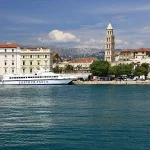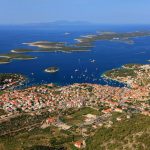From the beginning of 2018 the first competitors are predicted to be Italian maritime companies such as SNAV, Tirrenia, Moby Lines or Greek Anek Lines, Hellenic Seaway, Minoan Lines or Blue Star Ferries. Hellenic Seaway has around 30 ships and might be the toughest competitor
Are big players coming to the Adriatic? The Croatian national maritime company is due to see first competitors on tenders for concessions on 47 lines, with the first logically coming from Italy and Greece. Some have already expressed unofficial interest in Croatia, along with domestic competitors, where besides Jadrolinija with 34 lines and a fleet of 49 ships, other operators include Rapska Plovidba, Kapetan Luka, Linijska Nacionalna lovidba and other small companies, Novi List published on February 1, 2017.
There is always the possibility of new maritime companies or merging of smaller companies with foreign ones, so it is quite likely a large Adriatic battle is due. Jadrolinija as the biggest company will stand the toughest test, although its tradition, size and fleet quality provide a large advantage to adapt to the market. Jadrolinija is also to be credited with the current quality of island-mainland connections, which should not get any worse once the market is opened, something of strategic national interest to Croatia.
Although there are over 50 lines operating on the Croatian Adriatic, only five of them are profitable, meaning they are the only ones that can be maintained without state subsidies. Four of them are held by Jadrolinija, two of them connecting to Cres island in the north. Profitable is also the Prizna-Žigljen line to Pag island and Split-Supetar. The fifth is held by Rapska Plovidba on the Stinica-Mišnjak line to Rab island. Other than the number of passengers and vehicles, these lines also have short distances, meaning the lowest costs. Their commercial profitability does not mean they will be the most sought after on tenders, as profits will be limited by the concession fee amount, while other, less profitable lines will have state subsidies to secure connections to farther and less inhabited Croatian islands. Realistically the most attractive lines could be Split-Supetar.
The competition is interesting and strong, but operates in very different conditions than on the Croatian Adriatic. For example, the Italian SNAV already sails the international line Split-Ancona with a stop at Stari Grad on Hvar, but mostly sails in the Mediterranean and has ships suited for ling lines. Moby Lines has around 15 ships in the Mediterranean fleet and connects Elba, Sardinia, Sicily and Corsics, mostly long lines, where journeys last over ten hours, while only five lines last shorter than an hour. Very similar is the Tirrenia Group fleet, so these Italian companies mostly have ships with large capacity and furnished rooms and more comfort, mostly not needed on short lines.
The Greek Hellenic Seaways has around 30 ships, mostly large capacity, but this company is the most similar to Jadrolinija and may be its toughest competitor. As most others, the Blue Star Ferries company connects the largest Greek islands with large capacity ships of 1.000 vehicles and 2.000 passengers. It all shows that those ships would not be suited for Adriatic lines, but it must be said these are large maritime companies which can always decide to build or procure ferries for Adriatic lines. Greece also has smaller maritime companies, who already have ships that fit the needs of Adriatic islands, but they are also already in use in Greece, so no free capacity. There is the option of merging with Croatian companies or starting new ones to compete in tenders.
Tenders will be opened successively during this year up to the beginning of the high season. This is the last summer without any changes, while the next must have an open market in place. This was due to happen already this year, as Croatia agreed in her EU accession negotiations, but failed to meet the deadlines due to political instability.
Director of the Coastal Maritime Line Transport Agency Ivan Franičević confirmed there have been unofficial inquiries from foreign and domestic maritime companies, speaking of their potential interest in the Adriatic.
“I cannot say which companies, as there are often brokers, consultants or lawyers. My impression is they are all watching the situation and analysing if they will apply. We certainly have plenty of work ahead, with 47 lines due for tenders, 23 of them ferry lines, 14 fast ferry and 10 classic shipping lines. Tenders will mostly be out by the end of spring, successively so that everything can be decided until the end of the year and have contracts signed before January 1, 2018 for all lines. I feel it is wrong to predict the five most profitable lines will generate most interest. They are all equally interesting. We will prescribe the conditions and concession fee amount so that any lines can have a reasonable annual profit of around 8 percent. The most profitable liens will have the largest concession fees, up to ten percent from the current 2 percent. We are not interested in enabling enormous, but reasonable profit for any company. I also believe jobs are not in danger, as a condition is that sailors must know the Croatian language and meet Croatian standards in certificates, practically meaning crews will have to be Croatian even on foreign companies,” said Franičević, adding the Management Council of the Agency has not yet reached a decision on the length of the concession contracts, assuming they will last 6 years.
Preparations for competition are ongoing, with Rapska Plovidba investing around 8 million euro into building its largest ferry of 79 metres in length, with capacity of 100 vehicles and 600 passengers, due to increase their odds of keeping the Stinica-Mišnjak line to Rab island. Jadrolinija has in the past four years invested over 40 million euro in building 4 ferries for 145 vehicles and 600 passengers and procuring fast ferries Vida and Dora which are already in operation.
Jadrolinija management President Alan Klanac emphasises the company has been preparing strategically for years for the market liberalisation.
“We have great ambitions, to keep all the 34 lines we hold now. We have yet to see what will be the tender conditions prescribed by the Agency, if they will remain the same. Our mission is to put all our ships and personnel to work, so I feel it is possible we secure some new lines as well. Speaking of foreign competition, we can expect the Greek and Italian maritime companies to be strong opponents on international lines between the Croatian and Italian mainland, far less on short lines. I believe Jadrolinija is the most competitive, with room and options to join other markets, not only in the Mediterranean but also in other parts of Europe, especially short ferry lines, where we have large experience and knowledge,” Klanac concluded. As is evident, free international competition is coming to the Adriatic and is not necessarily bad, but only under the condition to maintain, if not improve, the current standard in connecting the mainland and islands.











